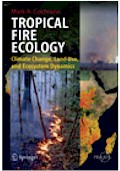| Book Chapter |
 |
|
| Title | Fire and land use effects on biodiversity in the southern Sumatran wetlands | | Author | Unna Chokkalingam, Iwan Kurniawan, S. Suyanto, Rizki Pandu Permana, Meilanie Buitenzorgy and Robiyanto Hendro Susanto | | Editors | Mark A Cochrane | | Year | 2009 | | Book Title | Tropical Fire Ecology: Climate Change, Land Use and Ecosystem Dynamics | | Publisher | Springer/Praxis | | Pages | 355-385 | | Call Number | BC0297-09 | | Keywords | Melaleuca cajuputi, Sumatra, peat, wetland, fire, biodiversity, GIS, Combretocarpus rotundatus, land use history, sonor |
|
| Abstract: |
| We studied the long-term effects of an intensified fire regime following logging and altered land use practices on the biodiversity and successional dynamics of forests on three sites (Sugihan, Mesuji and Pampangan) of roughly 300 km2 each, distributed across the continuous wetland ecosystem of southern Sumatra. Satellite image analysis and ecological and socio-economic surveys were combined to draw out the vegetation characteristics, and links to fire, land use history and site conditions.
Since the 1970s-80s, this ecosystem has been subject to widespread repeated fires associated with or following intensive logging, transmigration and plantation development, sonor or swamp rice cultivation, and other local resource use. Burn traces in the soil profile suggest that earlier fire episodes were far more limited in their coverage than the severe and frequent burning of the recent past. The result was a rapid transformation from mature high mixed-species forests to sedge-grasslands, savannahs and open to dense mono-specific stands of fast-growing fire-adapted species. Current vegetation types are largely differentiated by structural rather than
compositional differences, which are significantly linked to fire frequency or time since last fire. The more frequent and recent the fires, the more open the landscape with reduced density and basal area of trees.
At present, the area is very species poor. Most patches in Sugihan and Mesuji are dominated by a single species - Melaleuca cajuputi - in the tree, sapling and seedling layers except for degraded mixed forests which have a mix of species in all layers. Degraded mixed forests were more recently logged and burnt just once in 1991.
Pampangan has a different species composition with all patches dominated by Combretocarpus rotundatus in the tree layer, which is linked to greater organic matter depth. However in the deep peats of Pampangan also, the sapling and seedling layers are dominated by Melaleuca cajuputi in most patches suggesting a future shift in overstory composition to this more freshwater wetland-adapted species. This compositional shift is likely due to peat subsidence and increased likelihood of flooding following repeated burning.
The live fuel structure with tall dense lower to mid strata of flammable herbaceous and woody species and scattered to dense tree cover renders all the vegetation types extremely fire prone in dry years. The flammable vegetation combined with increased development and population pressures on these last frontiers makes continued widespread fires highly likely. This will lead to further simplification of species composition and structure, and degradation of the landscape into treeless plains.
Resource depletion has led to falling incomes and fewer livelihood options in southern Sumatra. Fires and their negative impacts have expanded into the northern provinces of Sumatra as well with timber and oil palm plantation development and/or migrating populations in search of livelihood options. Given the large contribution of peatland fires to transboundary haze, carbon emissions and global warming; reducing and controlling fires in the wetlands of Sumatra is of high priority. Fire management issues and options for the wetlands of southern Sum
atra are discussed. |
|
|
Download file(s): Click icon to download/open file.
|
| |
File Size |
Description |

|
- |
URL |
|
|
GRP 5: Improving the ability of farmers, ecosystems & governments to cope with climate change
GRP 6: Developing policies and incentives for multifunctional landscapes with trees that provide environmental services
|
| Viewed in 2506 times. Downloaded in 409 times. |